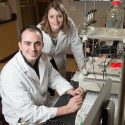Veterinarians embrace opportunity for public-health training
Rachel Klos is a veterinarian. So what is she doing working with the Wisconsin Division of Public Health’s community health surveillance and tracking program, ensuring that all newborn human babies born in the state get screened for hearing loss?
As the 2004 graduate of the University of Wisconsin–Madison School of Veterinary Medicine explains, it was UW–Madison’s inaugural master of public health (MPH) program, first offered in 2005, that opened this opportunity for her.
Initially interested in research, Klos found herself intrigued with food animals and population health as her veterinary education progressed.
"It’s not just this animal, but how you make a change that helps the entire herd," she says. "If you do those things right, it should cost less in the long run."
That same concept applied to human health is what public health is all about. So when she heard about the MPH program’s start, she decided to pursue the degree. She hopes to get more involved in infectious disease public health and zoonotic diseases in the future.
Many others in the veterinary profession were equally intrigued, to the point where veterinary medicine was one of the most-represented professions in UW–Madison’s inaugural year of the MPH program.
According to Patrick Remington, director of the program housed in UW–Madison’s Department of Population Health Sciences in the School of Medicine and Public Health, the veterinary medical students were a natural fit.
"They have a great understanding of the importance of public health, since many classic human health problems involve animals, including rabies, cryptosporidium and chronic wasting disease," Remington says. "By the end of the year, I think that the students had gained a new set of skills to enable them to understand these health issues better and be more effective in their practice in the future."
MPH program graduate Amy Karon, who completed her fourth year at the School of Veterinary Medicine in May, says, "It was a tremendous asset to expand beyond the DVM by working with physicians, nurses, pharmacists and other health professionals to gain an interdisciplinary perspective."
Karon completed the MPH portion of her dual DVM/MPH degree between her third and fourth years of veterinary medical training. Shared courses that apply to both programs help reduce the amount of time needed to earn both degrees
The interdisciplinary program was developed cooperatively between the schools of Medicine and Public Health, Veterinary Medicine, Nursing and Pharmacy and the La Follette School of Public Affairs, with important input from the state’s public health community.
Christopher Olsen, professor of public health and associate dean at the School of Veterinary Medicine who helped organize the program, notes that Wisconsin is one of the few universities that has all the major health schools (except dentistry) on one campus.
"This allowed us to make our program very interdisciplinary," he says. "The DVM/MPH dual degree allows students to blend the two programs such that they can complete both degrees in five years."
He notes that MPH participants receive training in core areas of epidemiology, biostatistics, environmental health, social and behavioral determinants of health, and health policy and administration, with opportunity for electives in the areas they’re most interested in.
Karon, who says she was always interested in zoonoses (infectious diseases that affect both animals and humans), has landed a prestigious and highly competitive two-year postdoctoral fellowship in applied epidemiology and public health practice with the Centers for Disease Control and Prevention’s Epidemic Intelligence Service.
In short, it’s a broadened perspective. Individuals with the dual DVM/MPH degree can take their veterinary medical knowledge and apply it to new directions that benefit both animals and people.
Subscribe to Wisconsin Ideas
Want more stories of the Wisconsin Idea in action? Sign-up for our monthly e-newsletter highlighting how Badgers are taking their education and research beyond the boundaries of the classroom to improve lives.



